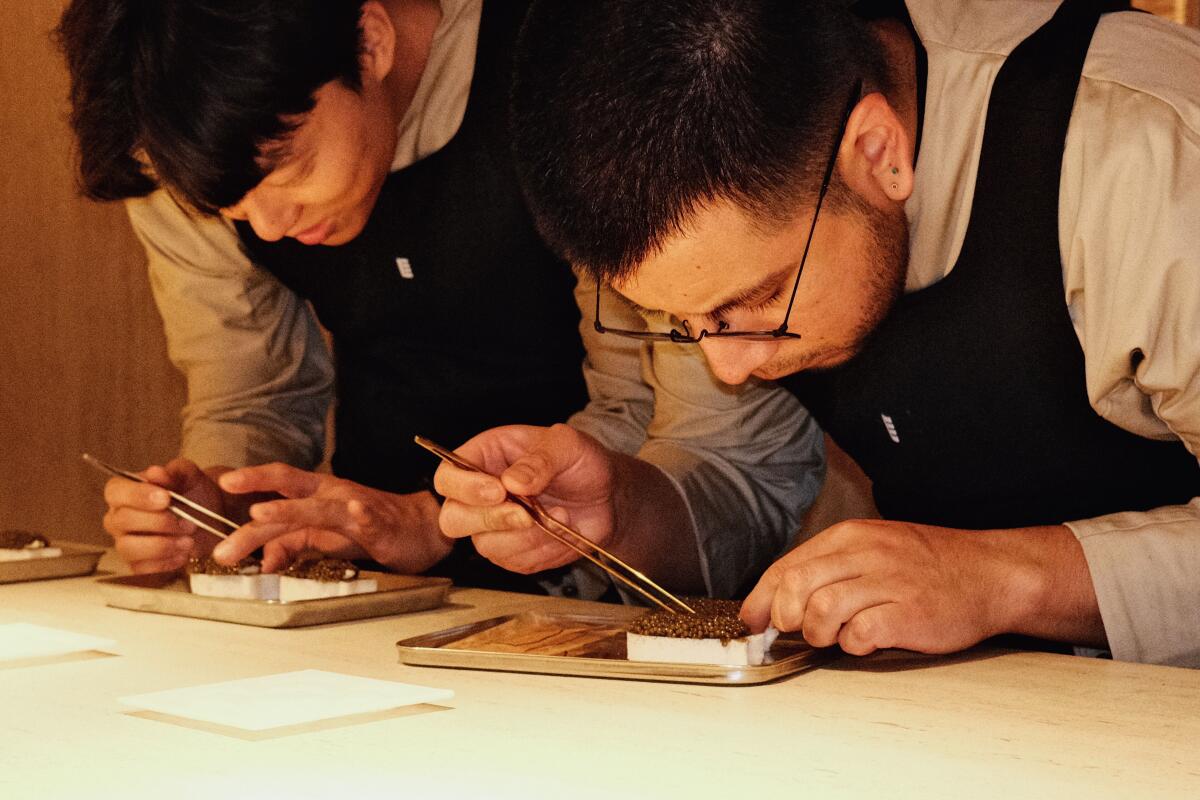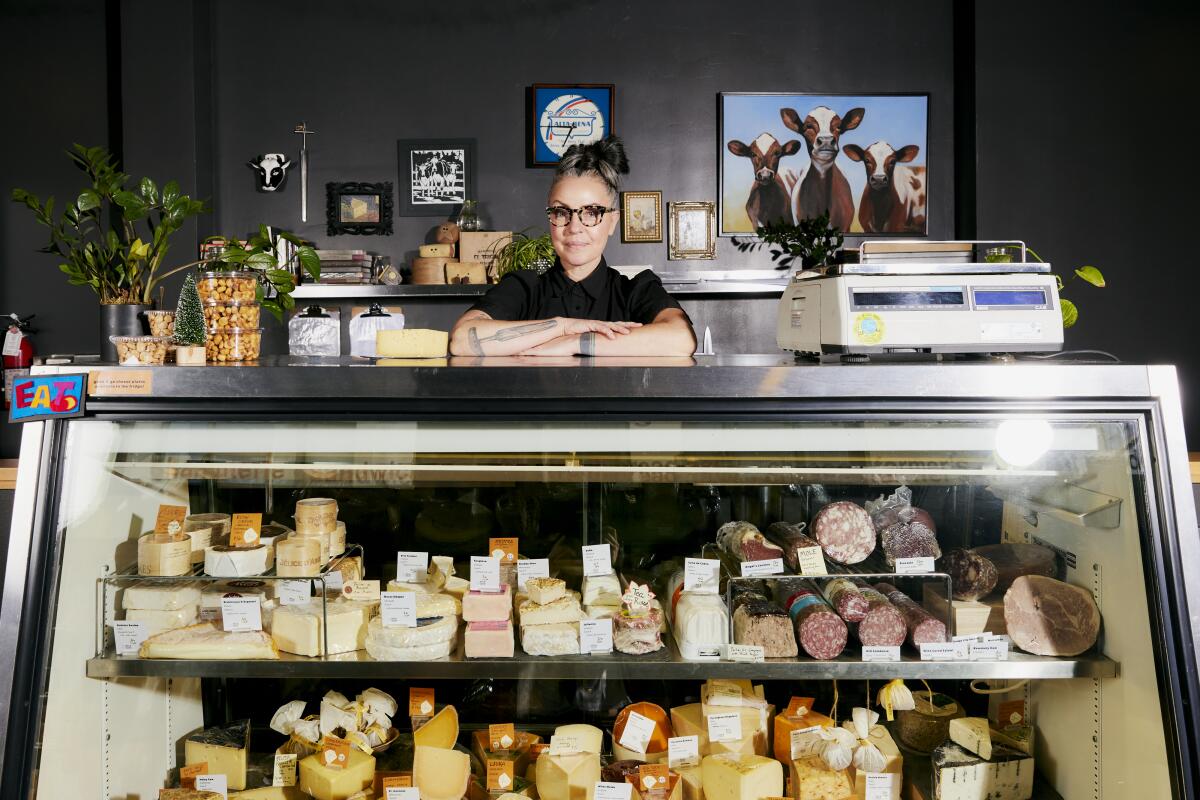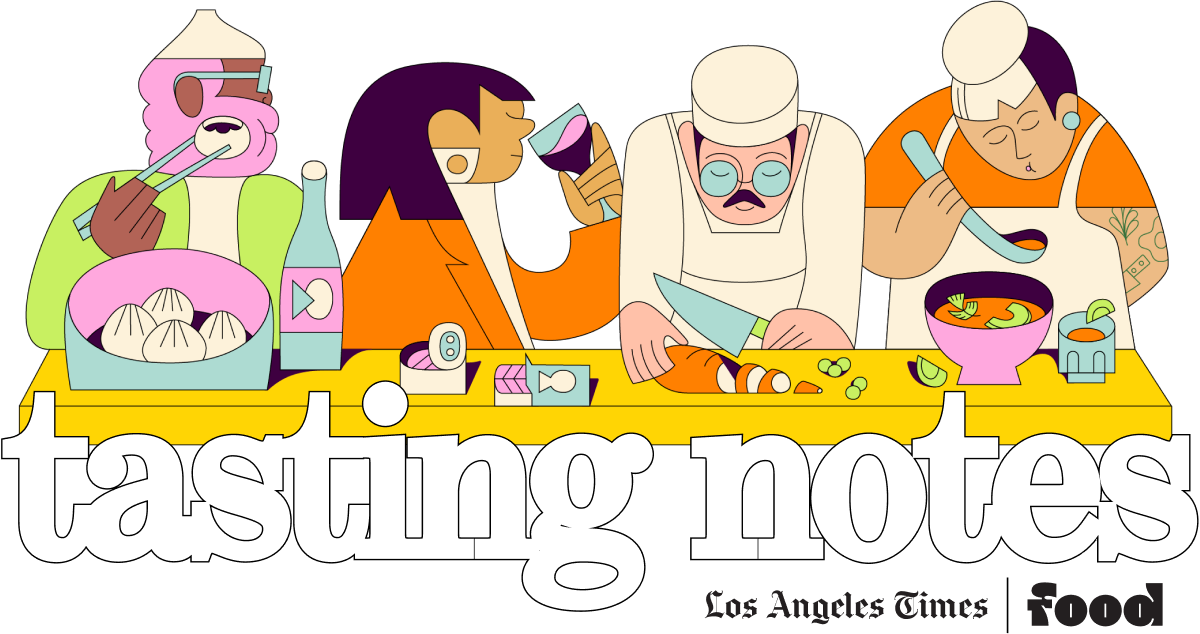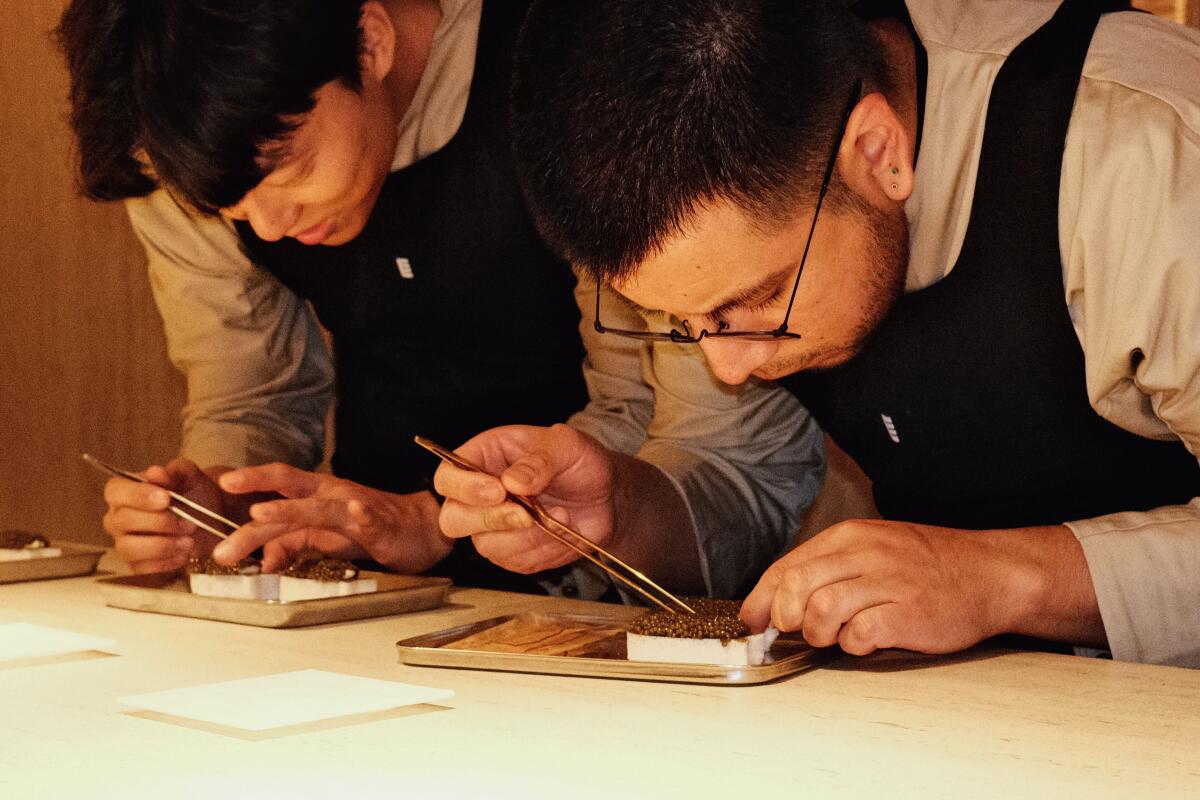L.A. is fully in the era of the $400 tasting menu. Plus, a golden era for Champagne, a good bowl of pho, Feast of the Epiphany pastry and cheese so good it could make you cry. I’m Laurie Ochoa, general manager of L.A. Times Food, with this week’s Tasting Notes.
Creativity amid adversity

Somni sous chef YeongSoo Lee, left, and another staff member prepare the caviar course at Somni in West Hollywood.
(Stephanie Breijo / Los Angeles Times)
There’s one story we publish each year that I dread reading — an accounting of the restaurants we’ve lost during the preceding 12 months. At the end of 2023, reporter Stephanie Breijo tracked an especially devastating toll with more than 65 notable closures. The tally as 2024 came to an end was even worse. Breijo took an extensive look at more than 100 notable restaurants that closed in 2024, from Zach Pollack‘s wonderful Italian spot Alimento and Lien Ta‘s All Day Baby to John Sedlar‘s too-short-lived Zozo, with many, many great places in between.
In May, Breijo led our package of stories on what might save L.A. restaurants with a report on the issues chefs and owners are struggling with, from rising prices to confusion over service fees. And Heather Sperling, co-owner of Botanica in Silver Lake, laid out why “of every $1 spent by a customer at Botanica in 2023, $1.005 went back out the door. “
This week, Cindy Carcamo reported that the challenges facing restaurants as 2025 begins aren’t getting any easier. Labor costs, delivery app fees and health insurance costs are among the seven most pressing issues restaurateurs are dealing with.
And yet … I would argue that as dire as things seem, Los Angeles is in the midst of a burst of creativity that is making this one of the most fascinating times to eat in the city.
In September, I wrote about some of the many ambitious and personal restaurants opening in Southern California during 2024, including Jordan Kahn‘s reopening of Vespertine, which almost immediately gained two Michelin stars and a spot on Bill Addison and Jenn Harris’ 101 Best Restaurants in L.A. list; Ricardo Zarate‘s intimate and affordable Hummingbird Ceviche House and Rashida Holmes’ Caribbean American Bridgetown Roti, not to mention Charles Namba and Courtney Kaplan‘s French Japanese bistro Camélia in the Arts District.
Since then, we’ve seen many more openings, including former Pearl River Deli owner Johnny Lee‘s Malaysian-inspired Rasarumah in Historic Filipinotown; the new live fire spot Bernee from All Time‘s Ashley and Tyler Wells; a permanent spot for Alex Garcia and Elvia Huerta‘s Evil Cooks and their “kamikaze” taco tasting menu; Michael Mina‘s Egyptian heritage restaurant Orla; plus two hugely ambitious projects that are sure to attract Michelin and World’s 50 Best inspectors — Aitor Zabala‘s Somni and Dave Beran‘s Seline.
There’s more to come this year with the 10-seat Little Tokyo spot Ki expected from Kinn‘s Ki Kim, and Daniel Patterson‘s anticipated return to cutting-edge dining at Jaca with his Alta Adams partner Keith Corbin (the two also reopened the community-focused Locol in Watts in August).
As Addison wrote in his recent review of Vespertine, “In a time of deep economic uncertainty in Los Angeles, when scores of community-centered neighborhood restaurants have buckled in the last year, a surge of sky-high fine dining appears on the horizon.”
It’s the ambition behind new and soon-to-open restaurants like Somni, Vespertine, Seline, Jaca and Ki plus all the creativity thriving at existing places — from Kato‘s Jon Yao working the Taiwanese flavors of his childhood into a tasting menu context, Brandon Hayato Go‘s seven-seat Hayato, Michael Cimarusti‘s sustainable seafood haven Providence and Kwang Uh‘s Korean inspiration for Baroo (The Times’ 2024 Restaurant of the Year) to Gilberto Cetina‘s extraordinary seafood counter Holbox in the unfussy Mercado la Paloma and Justin Pichetrungsi‘s side alley Thai Taco Tuesdays and more at Anajak Thai — that sets this moment apart from another troubled era in L.A. dining I witnessed years ago.
Way back in 1992, I wrote about how the recession was affecting Los Angeles’ dining scene. At that time, many restaurants lowered their ambitions, turning to comfort food and lower prices as they tried to ride out the storm. No one was reaching for Michelin stars.
“Food here can be wonderful,” I wrote at the time, “but no L.A. restaurant would earn three stars in France’s Michelin Guide. Luxury ingredients and service cost big money, and L.A. diners don’t want to pay. It’s telling that the most expensive restaurant in town, Sushi Ko, is Japanese. This is both our strength and our weakness. You don’t have to dress up to get a good meal in this town, and you don’t have to suffer through stiff service either.”
The democratization of L.A. dining can largely be attributed to the casual but chef-driven California cooking that Michael McCarty pioneered during the 1980s at Michael’s in Santa Monica and Wolfgang Puck‘s original Spago, where you could eat pizza alongside movie stars as well as grilled sweetbreads, whole snapper and veal liver.
Those democratic tendencies still exist in the DNA of L.A. restaurants — Holbox and Anajak are perfect examples of that. But while L.A. diners still resist dressing up for dinner, they are much more tolerant and even excited to experience new flavors in tasting menus. This is a moment when food lovers can expect the kind of artistic innovation that could reverberate for years to come.
But there is one caveat amid the creativity — and that is cost. It’s true that before the pandemic menu prices were not reflecting the actual cost of the food and labor it takes to run a restaurant. Prices have rightly risen as restaurants try to stay afloat. But we are now in an era of $400 tasting menus. Somni is charging $495 per person without wine. Hayato’s menu is $400 a person. Vespertine is $395. Providence and Kato are $325. Seline is $295. These prices, while justifiable when you consider the number of chefs and servers required for a cutting-edge tasting menu, put some of the city’s most artistic cuisine out of the reach of most diners.
Of course, one thing hasn’t changed, we are still a city where a $3 taco or a $10 bowl of noodles can be sublime.
Newsletter
You’re reading Tasting Notes
Our L.A. Times restaurant experts share insights and off-the-cuff takes on where they’re eating right now.
You may occasionally receive promotional content from the Los Angeles Times.
The cheesemonger stands alone

Lydia Clarke, co-owner of the DTLA Cheese Superette in Los Angeles.
(Jennelle Fong)
It’s impossible to talk cheese with Lydia Clarke without buying something from her DTLA Cheese Suprette that you can’t wait to get home and unwrap. There may be no greater advocate for what James Joyce called “the corpse of milk.”
Who better, then, for deputy food editor Betty Hallock to turn to for expert advice on creating the ultimate cheese board? I love that the story begins with Clarke’s eyes tearing up with emotion over the beauty of the creamline in a French-style goat cheese from Wisconsin called Shabby Shoe. As for cheese boards, Clarke likes to build drama with “a big chunk statement.” And the cheeses? She likes “something soft,” something “creamy,” “something Alpine” and “something blue.”
Also …
- Gov. Gavin Newsom and Robert F. Kennedy Jr. may disagree on many things, but both are critics of ultra-processed foods. On Friday — before the new Trump administration takes power with Kennedy, if confirmed, as secretary of Health and Human Services — Newsom issued an executive order that, as reporters Julia Wick and Taryn Luna write, “calls for proposals to reduce the purchase of candy, soda and other unhealthy foods made with synthetic dyes or additives by recipients of government food benefits” and “to develop recommendations to limit the health harms of ultra-processed foods.” This follows Newsom signing into law a 2023 bill to prohibit foods with the additives brominated vegetable oil, potassium bromate, propylparaben and red dye No. 3. Will the new Trump administration fight the order? We’ll have to stay tuned.
- Contributor David Rosoff, formerly of Osteria Mozza and co-founder of the late Bar Moruno, writes that “we are in the midst of a golden era for Champagne.” “The new generation is free to explore all manners of winemaking,” importer Paul Wasserman tells Rosoff, who then recommends five of the best of these next-gen Champagnes, most priced less than $100.
- Ahead of Pasadena hosting the Rose Bowl and Rose Parade on Wednesday, food columnist Jenn Harris wrote about some of her favorite places to eat in the City of Roses. Of course, her tips — including the macademia pancakes at Marston’s and the Dianne salad that’s been served since 1979 at Green Street Restaurant — are valuable any day of the year.
- Contributor Tiffany Tse put together a guide to 11 excellent places in L.A. to eat a comforting bowl of pho.
- De Los intern Cerys Davies surveys 10 L.A. panaderias that sell rosca de reyes, the Jan. 6 Feast of the Epiphany or Día de los Reyes pan dulce that includes “a small plastic baby, representing Jesus — whoever receives the slice with the baby inside is meant to make everyone tamales for Día de la Candelaria, which falls on Feb. 2.”
- Assistant food editor Danielle Dorsey went through our most recent reviews, guides and stories about restaurant openings to compile the best places to eat and drink in the L.A. area this month.
- And if you’re in the mood to cook this weekend, check Jenn Harris’ rundown of the 12 most popular recipes we published in 2024. I can highly recommend the No. 1 most popular recipe we ran — novelist and food writer Michelle Huneven‘s Roman-style chickpea and tomato soup with bulgur.
Newsletter
Eat your way across L.A.
Like what you’re reading? Sign up to get it in your inbox every week.
You may occasionally receive promotional content from the Los Angeles Times.

